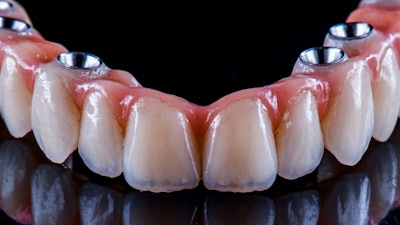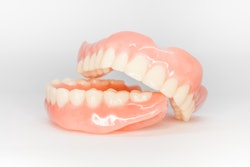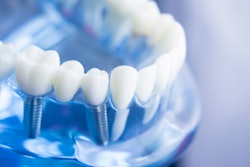
A magnetic system that uses reference points may enhance stability and safety when placing implant-supported fixed complete dentures. This technique was recently published in the Journal of Prosthetic Dentistry.
Furthermore, this technique aims to use magnetically coupled components to ensure precise positioning and ease of use during the fabrication of an implant-supported fixed denture, the authors wrote.
"A magnetically coupled tooth arrangement technique used the fixed reference point of integrated implants to determine maxillomandibular relations and the tooth arrangement, thus improving the efficiency of the clinical appointment,” wrote the authors, led by Omar Moustafa of the University of Louisville in Kentucky (J Prosthet Dent, November 1, 2024).
The technique
Follow these steps to place an implant-supported denture with improved clinical efficiency:
- Begin with a verified cast of the patient’s implants, sectioning three interim cylinders just above the screw heads.
- Attach these sectioned interim cylinders to three implants in a tripod configuration.
- Apply petroleum jelly to the cast, then mold a 1-mm layer of light-polymerizing custom tray material over the cylinders to create a U-shaped denture base.
- Place two to three magnets on the denture base to ensure balanced distribution.
- Polymerize the denture base as per manufacturer instructions, unscrew, and finish the edges.
- Add a second layer with additional magnets, trimming it shorter than the first, and polymerize.
- Detach the second layer from the first and smooth its edges.
- Create a wax rim on the removable denture base, and in the patient's mouth, attach the first base to the implants and insert the second with the wax rim.
- Obtain centric relation and facebow records, easily removing the wax rim as needed.
- Transfer occlusion rims to the cast and mount the maxillary and mandibular casts using the records.
- After mounting, arrange teeth on the wax rim and prepare for an aesthetic evaluation.
- In the patient’s mouth, attach the first denture base to the implants and place the second base with the tooth arrangement for adjustments.
"The described technique provided several advantages, including increased stability when obtaining records on the patient, increased clinical efficiency of the appointment and laboratory time, and increased safety for the patient by reducing the number of times implant prosthetic components must be inserted and removed from the mouth,” the authors wrote.




















